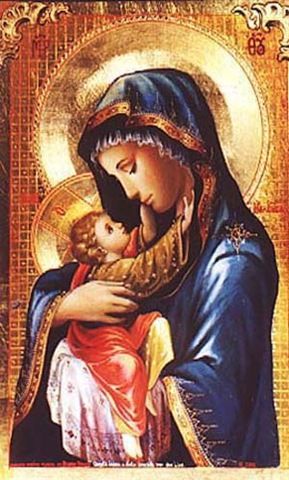Mary – the Mother of God and Mother of the Church
Mary’s motherhood is a divine source of heavenly splendor drawing God’s people to seek her intercessory grace without end.
She lovingly takes her sons and daughters by the hand and leads them to her Son Jesus Christ – the only begotten Son of God.
Becoming aware that she is chosen by God and blessed among women, Mary responds in total humility saying “Behold the Handmaid of the Lord” (Luke 1:38).
She is from the people, a pure woman also called to go the pilgrim way of faith.
Already filled with the grace of the Holy Spirit, Mary says “yes” to the divine Word and became the eternal mother of Jesus in the Incarnation. Impeded by no sin, she devotes herself totally to the person and work of her Son, under Him and with Him, by the grace of almighty God, serving the mystery of our redemption from sin.
To fully partake in the merits God bestows only to Mary, we must know why she is venerated as Mother of God and Mother of the Church.
The Virgin Mary surpasses all of creation because she is “Theotokos” (translated as “God-Bearer”) or Mother of God. The councils of Ephesus and Chalcedon proclaimed this title to put an end to the Nestorian heretical movement. “Mother of God” is primarily a Christological confession that Christ is the true, Incarnate Son of God.
It is from Mary’s redeemed human nature, flesh and blood that Christ Incarnate comes into the world as foretold by the prophet Isaiah (Is 7:14).
Mother of God

Mary was predestined from eternity by that decree of divine providence which determined the Incarnation of the Word to be the “Mother of God” and Mother of the Redeemer. God reveals his plan of salvation to the chosen one. By the power of the Holy Spirit, Mary brings the Redeemer into the world. In total obedience, she consents and says “may it be done to me according to thy word” (Lk 1:38).
In the fullness of grace that came upon her by the Holy Spirit, she becomes the Mother of God bringing forth from her womb the Savior – bodily giving life to Christ and spiritual life to baptized believers living as members of his Body.
In Mary’s acceptance to become the mother of the Son of God, she also accepts the fullness of redemption for the human race. She became the Mother of God because she was the Spouse of the Holy Spirit: the Holy Ghost shall come upon thee and the power of the Most High shall overshadow thee” (Lk 1:35). It is within the holy Temple of Mary’s womb that Jesus, the Son of God comes into the world. From the very moment the Holy Spirit acted within Mary, her entire being turns completely toward her Son Jesus, seeking to bring the world to his Sacred Heart.
In 1964, Pope Paul VI solemnly declares that the Virgin Mary is the Mother of the Church. The Second Vatican Council recalls that in the hierarchy of holiness it is precisely the “woman” Mary of Nazareth who is the figure of the Church. By reason of the gift and role of divine maternity, by which she is united with her Son, the Redeemer, the Blessed Virgin is also intimately united with the Church (LG 63).
Mother of the Church
Mary is united with the birth of the Church as “Mother” from its inception. On the Cross, Christ entrusts the disciple John in the hands of his Mother. Addressing Mary and John (thereby all of humanity) he says “Woman, this is your son, and to John: “this is your mother.” Thus, Mary the mother of Jesus Incarnate becomes the Mother of all believers, the Mother of the Church.
It is Christ who proclaims Mary’s spiritual Motherhood over the human race.
Just before his Ascension, Christ commands the apostles not to leave Jerusalem but to wait for the gift the Father promised (Acts 1:5). They are to go back to the upper room – the place of the Last Supper.
The Holy Spirit descends on the apostles at Pentecost – in the presence of Mary.
She is the new Eve and the virgin daughter of Israel, the mother of those who bear witness to Jesus (Rev 12:17). As Christ lay down his own life on the Cross for the redemption of the world, so does Mary in suffering give up her Son for the salvation of souls. There is no greater champion in carrying out the mission of the Church than the Mother of God.
She is God’s Masterpiece
The Immaculate “Motherhood” of Mary embodies both the Incarnate Christ and the living members of the Church. The links between our Lady and the Church are not only numerous as “one single and unique mystery”; they are essential and woven from within as two mysteries of faith. Moreover, when we speak about the “faith of the Church,” the perfect faith of Mary is venerated first followed by the faith of all believers in heaven and on earth in whom the Holy Spirit is actively present.
Through Mary’s tender love and total acceptance of the will of God, she brought forth the Lamb who takes away the sins of the world and brings everlasting life (Jn 1:29). For these reasons we love and honor Mary as the Mother of God and Mother of the Church.


